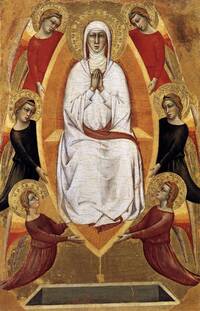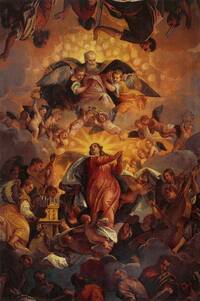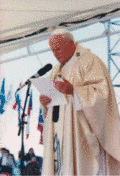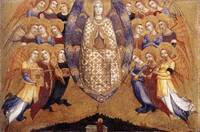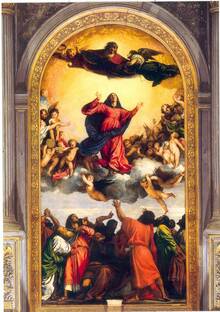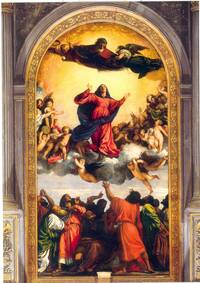The Assumption of Mary
4th Glorious Mystery of the Rosary
Solemnity - 15 August
Pope Francis's words in: 2020, 2019, 2018, 2017, 2016, 2015, 2014 (in South Korea) & 2013.
Papa Benedict XVI's words in: 2012, 2011, 2010, 2009, 2008, 2007, 2006 & 2005.
Saint John Paul II's words in: 2004 (in Lourdes), 2003, 2002, 2001, Jubilee 2000, 1999, 1998, 1997, 1996, 1995, 1994, 1993 (at WYD Denver) ![]() 1992, 1991 (at WYD Czestochowa), 1990, 1989, 1988, 1987, 1986, 1985 (in Kinshasa), 1984, 1983 (in Lourdes), 1982, 1981, 1980 & 1979.
1992, 1991 (at WYD Czestochowa), 1990, 1989, 1988, 1987, 1986, 1985 (in Kinshasa), 1984, 1983 (in Lourdes), 1982, 1981, 1980 & 1979.
Pope Pius XII defined the dogma of the Assumption in Deiparae Virginis Mariae & Munificentissimus Deus: "by the authority of our Lord Jesus Christ, of the Blessed Apostles Peter and Paul, and by my own authority, I pronounce, declare, and define it to be a divinely revealed dogma: that the Immaculate Mother of God, the ever Virgin Mary, having completed the course of her earthly life, was assumed body and soul into heavenly glory."
St JPII gave us his apostolic exhortation on St Joseph on this feast day in 1989.
3 2us by Fr Iain Matthew OCD ![]()
"Mary's assumption into heaven, as well as speaking of her littleness, also speaks of humanity's greatness. St John of the Cross has a phrase that God rejects nothing that is human, nor excludes anything human from this love: to love the Lord your God with all your heart and all your soul and all your mind. Everything human, soul and body, is fit for the glory of God. And Mary's assumption, soul and body, is a declaration that we - spirit, mind, heart, and body, this body that is so easily idolised or mistreated or kicked around in our world, is meant for glory, is sacred, is good. To be assumed into heaven means to be taken into the fullness of love.'
3 2us by Fr William Pearsall SJ ![]()
"This is a celebration not only of Mary, the one we love so dearly, but also of the whole of the Christian Church and, for that reason, very often the theology of the Blessed Virgin Mary will be linked directly to the theology of the Church, that is ecclesiology, our understanding of the Church, because what the Church says about Mary is what the Church proclaims about the work of redemption."
St JPII's homily on Solemnity of the Assumption at WYD Denver ![]()
Sunday 15th August 1993
"At her Assumption, Mary was "taken up to Life" – body and soul. She is already a part of "the first fruits" (1 Cor 15, 20) of our Saviour’s redemptive death and resurrection. The Son took his human life from her; in return He gave her the fullness of communion in divine life. She is the only other being in whom the mystery has already been completely accomplished. In Mary the final victory of Life over death is already a reality. And, as the Second Vatican Council teaches: "In the most holy Virgin the Church has already reached the perfection whereby she exists without spot or wrinkle" (Lumen Gentium, 65). In and through the Church we too have hope of "an inheritance which is imperishable, undefiled, and unfading, kept in heaven for us" (cf 1 Pet 1, 4).
Catechesis with St John Paul II
The Assumption of Mary, a truth of faith ![]()
"Munificentissimus Deus, by making reference to the participation of the woman of the Proto-gospel in the struggle against the serpent and by recognizing in Mary the New Eve, presents the Assumption as the consequence of Mary’s union with Christ’s redeeming work. In this regard it affirms: "Consequently, just as the glorious Resurrection of Christ was an essential part and the ultimate trophy of this victory, thus it was necessary that the combat undergone by the Holy Virgin, united to her Son, should end with the glorification of her virginal body". The Assumption is therefore the culmination of the struggle which engaged the generous love of Mary in the redemption of humanity and is the fruit of her unique participation in the victory of the Cross."
The Assumption of Mary in the tradition of the Church ![]()
"Looking at the mystery of the Virgin's Assumption it is possible to understand the plan of divine Providence relative to humanity: after Christ, the Verb Incarnate, Mary is the human creature who realises first the eschatological ideal, anticipating the fullness of happiness, promised to the elect through the resurrection of bodies."
Catechesis with Pope Benedict XVI 
Castel Gandolfo, General Audience, Wednesday 16 August 2006 - also in Croatian, French, German, Portuguese, Spanish & here below in Italian
"Dear brothers and sisters,
Our customary weekly Wednesday appointment takes place today still in the climate of the solemnity of the Assumption of the Blessed Virgin Mary. So I would like to invite you to turn your gaze, once again, towards our heavenly Mother, whom yesterday the liturgy made us contemplate triumphant with Christ in Heaven. Since the first centuries of Christianity, this feast has always been deeply felt by the Christian people; as is well known, it celebrates the glorification, also bodily, of that creature whom God chose as Mother and whom Jesus on the Cross gave as Mother to all humanity. The Assumption evokes a mystery that interests each one of us because, as the Second Vatican Council affirms, Mary "shines here below as sign of sure hope and consolation for the people of God who are on the pathway" (Lumen Gentium, 68). However, we are so caught up in the events of each day as to sometimes forget this consoling spiritual reality, which constitutes an important truth of faith.
How then can we make this luminous sign of hope be perceived more and more by all of us and by today's society? There are those today who live as if they would never have to die or as is everything must end with death; others, holding that man is the unique architect of his own destiny, behave as if God did not exist, sometimes even going so far as to deny that there is room for Him in our world. The great successes of technology and science, which have considerably improved humanity's condition, leave unsolved however the deepest questions of the human soul. Only openness to the mystery of God, who is Love, can quench the thirst for truth and happiness in our hearts; only the prospect of eternity can give authentic value to historical events and above all to the mystery of human fragility, of suffering and of death.
In contemplating Mary in celestial glory, we understand that for us too the earth is not the definitive homeland and that, if we live turned towards eternal goods, we will one day share her same glory and the earth will also become more beautiful. For this reason, even amidst the thousands of daily difficulties, we must not lose serenity and peace. The luminous sign of Our Lady assumed into heaven shines out even more when sad shadows of suffering and violence seem to accumulate on the horizon. We are certain of it: from on high, Mary follows our steps with sweet trepidation, she comforts us in the hour of darkness and storm, she reassures us with her maternal hand. Sustained by this awareness, let us continue with trust on our pathway of Christian commitment there where Providence leads us. Let us, under Mary's guidance, go forward in our lives. Thank you."
La Solennità dell’Assunzione della Beata Vergine Maria 
Meditazione di Papa Benedetto
Udienza Generale, Castel Gandolfo, Mercoledì 16 agosto 2006
"Cari fratelli e sorelle,
il nostro consueto appuntamento settimanale del mercoledì si svolge quest’oggi ancora nel clima della solennità dell’Assunzione della Beata Vergine Maria. Vorrei pertanto invitarvi a volgere lo sguardo, ancora una volta, alla nostra Madre celeste, che ieri la liturgia ci ha fatto contemplare trionfante con Cristo in Cielo. Questa festa è stata sempre molto sentita dal popolo cristiano, fin dai primi secoli del cristianesimo; essa, com’è noto, celebra la glorificazione anche corporale di quella creatura che Dio si è scelto come Madre e che Gesù sulla Croce ha dato per Madre a tutta l’umanità. L’Assunzione evoca un mistero che interessa ciascuno di noi perché, come afferma il Concilio Vaticano II, Maria "brilla quaggiù come segno di sicura speranza e consolazione per il popolo di Dio che è in cammino" (Lumen gentium, 68). Si è però talmente presi dalle vicende di ogni giorno da dimenticare talora questa consolante realtà spirituale, che costituisce un’importante verità di fede.
Come far sì allora che questo segno luminoso di speranza sia percepito sempre più da noi tutti e dall’odierna società? C’è oggi chi vive come se non dovesse mai morire o come se tutto dovesse finire con la morte; alcuni si comportano ritenendo che l’uomo sia l’unico artefice del proprio destino, come se Dio non esistesse, giungendo qualche volta persino a negare che ci sia spazio per Lui nel nostro mondo. I grandi successi della tecnica e della scienza, che hanno notevolmente migliorato la condizione dell’umanità, lasciano però senza soluzione i quesiti più profondi dell’animo umano. Solo l’apertura al mistero di Dio, che è Amore, può colmare la sete di verità e di felicità del nostro cuore; solo la prospettiva dell’eternità può dare valore autentico agli eventi storici e soprattutto al mistero della fragilità umana, della sofferenza e della morte.
Contemplando Maria nella gloria celeste, comprendiamo che anche per noi la terra non è la patria definitiva e che, se viviamo rivolti ai beni eterni, un giorno condivideremo la sua stessa gloria e diventa più bella anche la terra. Per questo, pur tra le mille difficoltà quotidiane non dobbiamo perdere la serenità e la pace. Il segno luminoso dell’Assunta in cielo rifulge ancor più quando sembrano accumularsi all’orizzonte ombre tristi di dolore e di violenza. Ne siamo certi: dall’alto Maria segue i nostri passi con dolce trepidazione, ci rasserena nell’ora del buio e della tempesta, ci rassicura con la sua mano materna. Sorretti da questa consapevolezza, proseguiamo fiduciosi nel nostro cammino di impegno cristiano là dove la Provvidenza ci conduce. Andiamo, sotto la guida di Maria, avanti nella nostra vita. Grazie."
Saluti:
"Je salue cordialement les pèlerins francophones présents ce matin. Puisse la Bienheureuse Vierge Marie, dont nous avons célébré hier l’Assomption, demeurer, pour vous et pour le peuple de Dieu tout entier, « comme un signe d’espérance assurée et de consolation » (Lumen gentium n. 68). Dans ce monde marqué par la fragilité humaine, la souffrance et la mort, que notre Mère du Ciel vous fasse entrer toujours plus profondément dans le mystère de Dieu, qui est Amour, seul capable d’étancher la soif de vérité, de bonheur et d’éternité de vos cœurs.
I am happy to greet all the English-speaking pilgrims and visitors present at this audience, including the altar servers from Malta, and the groups from England, Ireland, Canada, Nigeria and the United States of America. Yesterday we contemplated the Virgin Mary’s Assumption into Heaven. This mystery reminds us that our definitive homeland is not here on earth, and that our longing for fulfilment finds complete satisfaction only in eternal happiness. May Our Mother in Heaven, who guides us on our way, inspire us with courage and hope through the struggles of our daily life! I wish you a pleasant stay, and may God bless you all!
Ein herzliches Willkommen hier in Castelgandolfo sage ich den Einzelpilgern und Gruppen aus den deutschsprachigen Ländern. Unter den verschiedenen Pilgergruppen aus Deutschland grüße ich ganz besonders die Landsleute aus Pentling bei Regensburg, die gemeinsam mit einer Abordnung ihrer italienischen Partnergemeinde Corciano aus Umbrien hierher gekommen sind. Euch allen, liebe Brüder und Schwestern, wünsche ich von ganzem Herzen gesegnete und kräfteerneuernde Urlaubstage in Italien. Möge Gott, der Herr unseres Lebens, euch auf all euren Wegen mit seiner Liebe und Gnade begleiten!
Queridos hermanos y hermanas: Recordando la festividad de ayer, la Asunción de la Virgen María, la contemplamos triunfante con Cristo en el Cielo. Esta celebración evoca un misterio que afecta a cada uno de nosotros, como enseña el Concilio Vaticano II, María "brilla ante el Pueblo de Dios en marcha, como señal de esperanza y de consuelo" (LG, 68). Sólo la apertura a la eternidad y al misterio de Dios, que es Amor, puede colmar la sed de verdad y felicidad de nuestro corazón. María, que sigue nuestros pasos, nos ayuda con su mano materna, especialmente en las dificultades diarias y las situaciones de dolor o violencia. Así podemos seguir confiados en nuestro camino cristiano. Gracias por vuestra atención.
Saúdo os grupos de língua portuguesa vindos do Brasil e de Portugal, e convido a dirigir o olhar à nossa Mãe celestial, dando graças a Deus porque ontem a liturgia nos ajudou a contemplá-La triunfante com Cristo no Céu. Com a minha Bênção Apostólica!
Pozdrawiam obecnych tu Polaków. Nasze dzisiejsze spotkanie odbywa się nadal w klimacie uroczystości Wniebowzięcia Najświętszej Maryi Panny. Jest to tajemnica, która dotyczy każdego z nas, gdyż wskazuje, że naszym ostatecznym przeznaczeniem jest chwała nieba, w której oczekuje na nas kochająca Matka. Niech codzienne troski nie przesłaniają nam tej pocieszającej rzeczywistości duchowej. Niech będzie żywe w nas pragnienie spotkania z naszą Matką i Jej Synem w domu Ojca.
E vorrei salutare particolarmente anche i pellegrini venuti dall'Ucraina. Grazie!
Rivolgo un cordiale saluto ai pellegrini di lingua italiana, in particolare alle Piccole Suore della Sacra Famiglia e alle Missionarie Figlie del Calvario, che stanno celebrando in questi giorni i rispettivi Capitoli generali, alle Figlie della Croce di Sant’Andrea e alle Suore della Santa Croce.
E finalmente vorrei salutare di cuore anche tutti i pellegrini riuniti in Piazza San Pietro a Roma. Estendo il mio saluto a tutti giovani presenti, sono tanti. Qui ci sentiamo ringiovaniti tutti! Estendo il mio saluto ai malati e agli sposi novelli. Carissimi, la luce di Cristo, che abbiamo contemplato ieri riflessa in Maria Santissima Assunta in Cielo, illumini sempre la vostra vita e la renda feconda di bene.
Vorrei finalmente concludere questo nostro incontro con un ricordo particolare per Frère Roger Schutz, fondatore di Taizé, assassinato proprio un anno fa, il 16 agosto dello scorso anno, durante la preghiera della sera. La sua testimonianza di fede e di dialogo ecumenico è stata un prezioso insegnamento per intere generazioni di giovani. Chiediamo al Signore che il sacrificio della sua vita contribuisca a consolidare l’impegno di pace e di solidarietà di quanti hanno a cuore il futuro dell’umanità.
Concludiamo come sempre questa udienza con il canto comune del Padre Nostro."
Apostolic Constitution of Pope Pius XII
on the Assumption of the Blessed Virgin Mary:
The Fathers of the Church, the great Doctors, in the sermons they preached on the feast of the Assumption of the Mother of God, had as their theme a doctrine which all the Christian world already knew and accepted; it was for them to elaborate it, to bring out the essential meaning of it, beyond what lay on the surface. To say that the body of the Blessed Virgin never knew decay was not to exhaust the meaning of this solemnity. What we celebrated was the triumph she won over death when she was glorified, after the pattern of her only Son Jesus Christ in heaven.
Thus Saint John Damascene, the interpreter of this tradition par excellence, makes an eloquent comparison between the high privileges conferred on the Mother of God in general, and her bodily Assumption. ‘It was fitting that she who in giving birth had preserved her virginity unspotted should keep her body incorrupt even after death. It was fitting that she who had borne the Creator as a child in her bosom should have a dwelling-place with God. It was fitting that the bride espoused by the Father should dwell in the bridal-chambers of heaven. It was fitting that she who had gazed on her Son on the cross, receiving then in her breast the sword of sorrow she had been spared at his birth, should behold him seated with the Father. It was fitting that the Mother of God should enjoy the privileges of the Son and should be honoured by all creation as the Mother and the handmaid of God.’
Saint Germanus of Constantinople sees the translation of Our Lady’s incorrupt body as fitting in, not only with her divine motherhood, but with a special sanctity which attaches to its virgin state: ‘You appear in beauty, as it is written, and your virginal body is altogether holy, altogether chaste, altogether God’s dwelling; so that it can never know dissolution into dust; transformed indeed, because human, to the glory of incorruptible life; yet, the same body, living and glorious, preserved from harm, sharing in perfect life.’
Another very ancient writer states: ‘Being the most glorious Mother of Christ the Saviour, our God, who bestows life and immortality, she is restored to life by him, and in her body shares for evermore bodily incorruptibility with him who raised her from the grave and assumed her to himself in a manner known only to himself.’
In the last resort, all these Fathers base their conclusions on the Bible, which has given us the picture of our Lord’s Mother as inseparably attached to her divine Son, and constantly sharing his lot.
It is to be remembered that, from the second century onwards, Our Lady has been identified by the Fathers of the Church as the second Eve. Not on the same level, indeed, as the second Adam, but intimately associated in his warfare against the enemy of our race. It was to issue, as we know from the promised made in paradise, in a complete triumph over sin and death, those twin enemies that are so often coupled together by Saint Paul. Of this victory, Our Lord’s resurrection is the operative part, the supreme trophy; but Our Lady, too, who shared in the conflict, must share in its conclusion, through the glorifying of that virgin body of hers. Only then, as the apostle says, ‘when this mortal nature wears its immortality, the saying of scripture will come true, Death is swallowed up in victory’.
Great Mother of God, so wondrously united with Jesus Christ, from all eternity, by the same decree of providence; in her conception immaculate, in her divine motherhood a virgin most pure, the noble associate of our Redeemer in his victory over sin and its consequences – what reward awaited her at last? For the crown of all her graces, she was exempted from the sentence of decay; shared her Son’s victory over death, and was carried up to heaven, soul and body, there to reign as queen at his right hand, who is the King of Ages, the immortal.
Saint Amadeus of Lausanne (1108-1159; Cistercian monk, then Bishop)
Homily in praise of the Blessed Virgin Mary VII, SC 72 (On the praises of the Blessed Virgin Mary: 8 homilies, trans. Grace Perigo. Kalamazoo: Cistercian publications Inc, 1979)
"You are blessed of all women" (Lk 1, 42)
But now, who would worthily extol her holy assumption? Who unfold in words how joyfully she went forth from the body, how joyfully she beheld her Son, how exultingly she hastened to the Lord, attended by choirs of angels, supported by the reverence of apostles, while she beheld the King in his beauty. She was brought forth from the house of her flesh to live for ever with Christ. She passed over in the vision of God, she breathed out to God her blessed soul, brighter than the sun, higher than the heavens, of more worth than the angels. (…)
Is it not life when one goes to the source of life and drinks eternal life from life in an unbroken stream? Of this unfailing draught the virgin Mother tasted even before her death, so that in her very passing she should not be touched by the slightest taste of death. Therefore as she went forth she saw life, that she might not see death. She saw her Son that she might not grieve at her separation from the flesh. Therefore going out free with such a happy vision and being possessed of the face of God that she had longed for, she found the revered citizens of heaven ready to render service and attend her.

